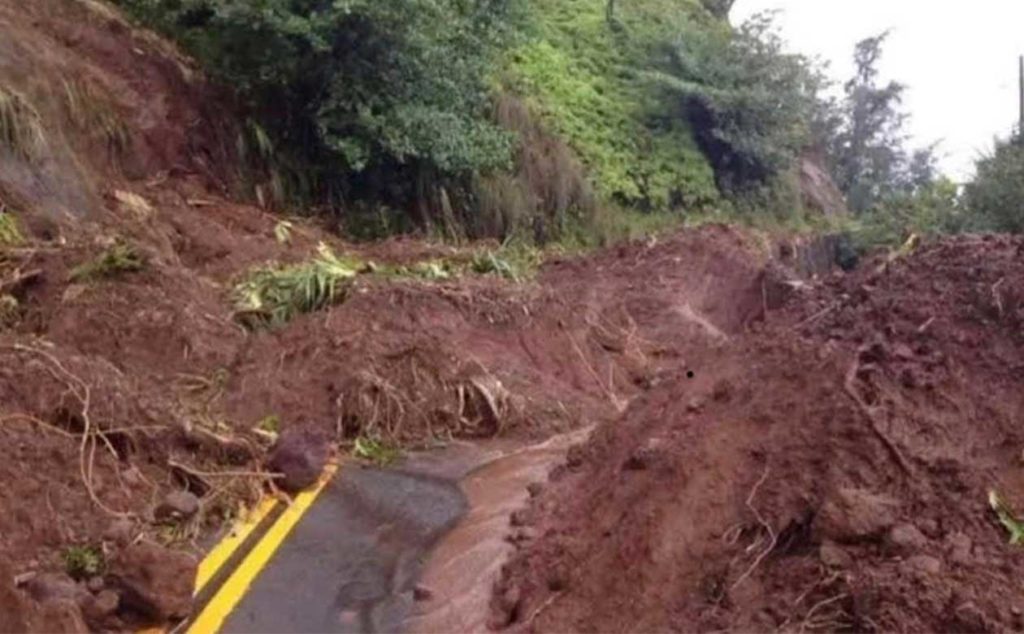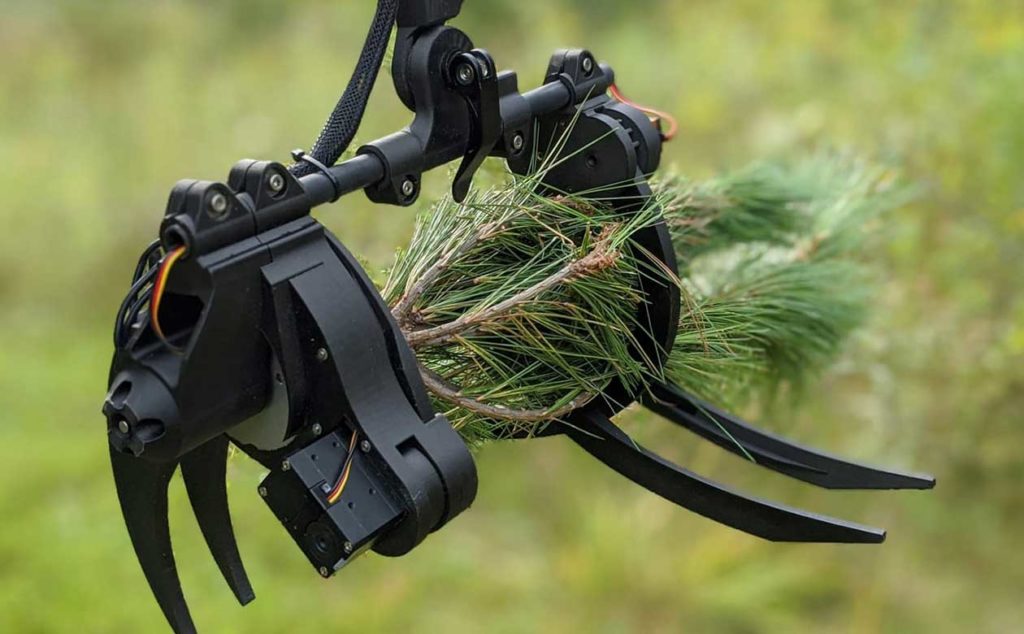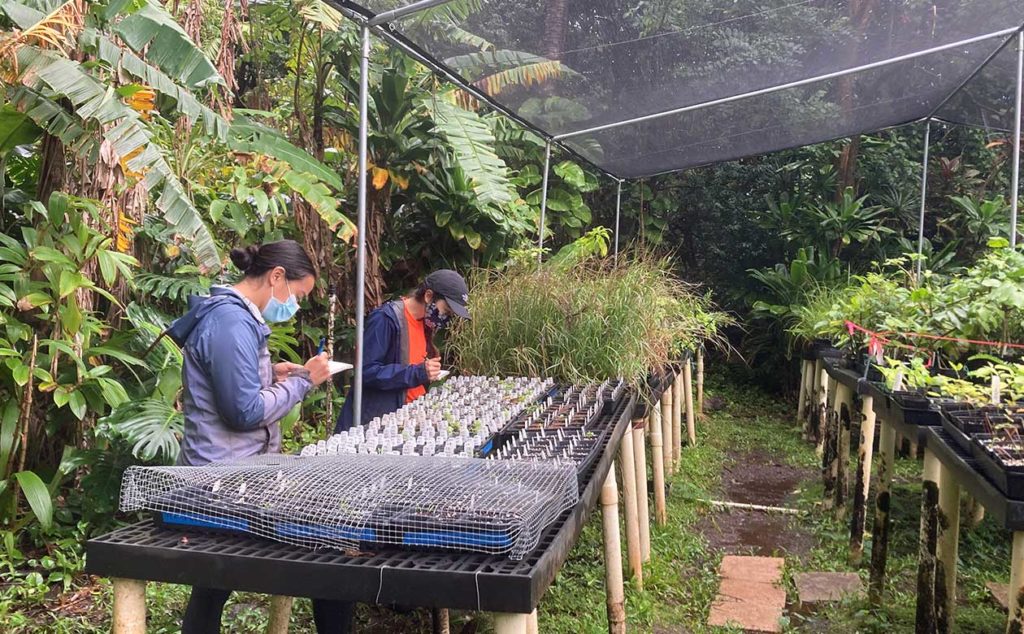On March 11, 2021, thick bands of heavy rain stretched across the Hawaiian Islands. While wet weather isn’t uncommon in the state this time of year, rainfall rates of more than 3 inches per hour certainly are. On the North Shore of Oahu, the storm caused catastrophic flooding and forced evacuations. On Maui, the intense rainfall washed out bridges, dams and damaged homes. On Kauai, landslides closed Kuhio highway in both directions at Hanalei; an area hit hard by the record-breaking rain bomb of 2018. All of the National Tropical Botanical Garden locations in Hawaii were closed, and some suffered damage to infrastructure and living collections.

Unfortunately, this kind of story isn’t unique to Hawaii. The climate is changing all around the world. Climate models project that tropical regions worldwide will experience more significant swings in temperature and rainfall, prolonged droughts, and a more substantial threat from tropical storms and cyclones.
“Climate change affects nearly every aspect of the human-natural ecosystems in the Hawaiian Islands,” says Dr. Uma Nagendra, Conservation Operations Manager and Ecologist at NTBG’s Limahuli Garden and Preserve. “Rising sea levels threaten roadways, houses, and coastal farmlands as well as endangered native lowland waterbirds. Increasing temperatures and droughts threaten local food security. On Kauai, we have seen firsthand how landslides, powerful storms, and wildfires can isolate and devastate entire communities and ecosystems,” she continued.
“Climate change affects nearly every aspect of the human-natural ecosystems in the Hawaiian Islands”
In April 2018, a massive storm dropped 50 inches of rain in 24-hours on Kauai’s North Shore, setting a new U.S. rainfall record. Streams overflowed, homes and highways washed away, and many large-scale landslides buried vast swaths of forest, destroying native plant habitat. Cliffsides were left barren, and exposed soil offered an open invitation to invasive weeds that don’t provide the same ecosystem services as native forests because many fast-growing invasive plants are shallow-rooted, which can leave the landscape vulnerable to further erosion.
After this record-breaking event, NTBG scientists and conservation professionals returned to the field and the lab to apply ancient knowledge, new science and technology to save plants and continue to bring local and global climate solutions into focus.
“The most important lessons we can learn from the past are how to adapt and be resilient as the world changes,” says Dr. Nagendra. “Part of that is taking care of the ecosystems that sustain us with fresh water, stable land, and food. During the 2018 flood, we saw thousand-year-old structures withstand heavy flooding that infrastructure from the 1970s couldn’t handle,” she remarked.
To build resiliency and protect ecosystems from the unpredictability of climate change, threatened and endangered native plants must survive in botanical gardens and their natural habitats. The Limahuli Valley is the second most biodiverse valley in Hawaii, making it the ideal location for NTBG’s watershed-based conservation program at Limahuli Garden and Preserve.
“The most important lessons we can learn from the past are how to adapt and be resilient as the world changes.”
The biocultural conservation program at NTBG’s Limahuli Garden collaborates with land stewards in the neighboring valleys to restore health and function to the social-ecological system that native Hawaiians have sustainably managed for more than 1,000 years. The ahupuaa system provides philosophies and practices for maintaining biodiversity, ensuring forest health, protecting stream integrity, creating fertile agricultural fields, promoting an abundant near-shore fishery from mauka to makai (mountain to ocean), and acknowledges that humans are part of the ecosystem.
National Tropical Botanical Garden has a long history of plant exploration and discovery. Nearly 90% of Hawaiian plants don’t grow anywhere else on Earth and are particularly susceptible to competition from invasive species and climate change because they evolved in isolation. Since the mid-1970s, NTBG botanists have navigated, climbed, and rappelled challenging terrain to hand-pollinate and collect material, including seeds, from rare plants.

While NTBG botanists still work in the field, the addition of drone technology has allowed them to survey previously inaccessible areas and find new populations of rare plants – some thought to be already extinct in the wild. “In Hawaii, we are working as quickly as possible to collect, store and propagate rare plants in case suitable habitat disappears,” says Ben Nyberg, NTBG GIS specialist and drone pilot. “We are developing drone systems that can be applied by conservationists around the world to combat climate change in a number of ways, from survey to collection to reintroduction,” he continued.
Documenting and collecting plant material is one step in the conservation process. Once rare plant populations are discovered and seeds collected, NTBG and partners must work together to store and propagate the plants safely.
We are developing drone systems that can be applied by conservationists around the world to combat climate change in a number of ways, from survey to collection to reintroduction.”
Seed banking is a vital ex-situ or off-site conservation practice that helps protect plants from climate change, invasive species, and habitat loss. The NTBG Seed Bank and Laboratory currently store more than 15 million seeds from 533 native Hawaiian taxa. To store seeds wild-collected from native plants in the Limahuli preserve or remote cliffsides, seeds first must be meticulously cleaned to remove all fruit remnants. Once cleaned, information about when and where biologists collected the seed is recorded in NTBG databases, and research is conducted to determine if and how they can be stored long-term.

“Back in the early 1990s, we thought that because of our geographic location in the tropics, seeds of most species would not be able to be conserved using conventional storage methods,” says Dustin Wolkis, NTBG Seed Bank and Laboratory Manager. “Thanks to our collaboration with the Hawaii Seed Bank Partnership and other institutions, we have been able to conduct long-term monitoring and have found exactly the opposite,” he noted.
With more than 30 years of storage and viability data, NTBG and seed banking partner institutions can better understand trends and predict the storage behavior and viability of rare seeds giving new hope to many of Hawaii’s rare and endangered species.
“Back in the early 1990s, we thought that because of our geographic location in the tropics, seeds of most species would not be able to be conserved using conventional storage methods. We have been able to conduct long-term monitoring and have found exactly the opposite.”
At the intersection of ancient knowledge, new technology, and seed science sits an exciting new research project that could be a game-changer for Hawaii’s endangered plants. NTBG conservation staff at Limahuli Garden are currently investigating the use of drone technology as a means of revegetating landslide areas on Kauai. “The extreme rain and numerous landslides we have already seen on Kauai are exactly what we expect to see from climate change,” said Dr. Nagendra. “Conservation staff at Limahuli are working with Ben and the drone program to develop ways of using drones to distribute seeds and revegetate exposed soil with native plants after landslide events. We’re currently using seed trays to test the idea and see if it’s viable,” she continued.

In addition to the possibility of revegetating with drones, ongoing research with DeLeaves and the University of Sherbrooke in Quebec is aimed at customizing drone sampling mechanisms to remotely collect plant material such as seeds or cuttings, and reach plant populations on steep or rocky cliffsides that have been largely unreachable. “Covid certainly delayed our field tests,” says Ben Nyberg, “but we have been able to collaborate and develop the robotics remotely. Field trials have been scheduled for later this summer and we are excited to get to work.”
Plants are one of our best defenses against our changing climate. They are the foundation of healthy ecosystems and can increase climate stability by offsetting temperature, moisture, and greenhouse gas fluctuations. From ancient knowledge to field surveys and seed storage, National Tropical Botanical Garden works at every level to discover solutions and save plants. You can help by. Visit our support page to see how you can get involved.